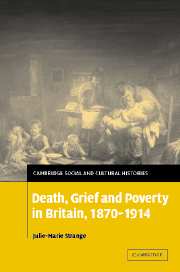Book contents
- Frontmatter
- Contents
- Acknowledgements
- List of abbreviations
- 1 Introduction: revisiting the Victorian and Edwardian celebration of death
- 2 Life, sickness and death
- 3 Caring for the corpse
- 4 The funeral
- 5 Only a pauper whom nobody owns: reassessing the pauper burial
- 6 Remembering the dead: the cemetery as a landscape for grief
- 7 Loss, memory and the management of feeling
- 8 Grieving for dead children
- 9 Epilogue: death, grief and the Great War
- Bibliography
- Index
4 - The funeral
Published online by Cambridge University Press: 05 July 2009
- Frontmatter
- Contents
- Acknowledgements
- List of abbreviations
- 1 Introduction: revisiting the Victorian and Edwardian celebration of death
- 2 Life, sickness and death
- 3 Caring for the corpse
- 4 The funeral
- 5 Only a pauper whom nobody owns: reassessing the pauper burial
- 6 Remembering the dead: the cemetery as a landscape for grief
- 7 Loss, memory and the management of feeling
- 8 Grieving for dead children
- 9 Epilogue: death, grief and the Great War
- Bibliography
- Index
Summary
As an organised and identifiable set of customs centred on the disposal of the corpse, the funeral has featured prominently in analyses concerning Western attitudes towards death. The Victorian funeral has attracted particular interest on account of its perceived opulence. Indeed, the meanings invested in the Victorian funeral have been explored almost entirely in terms of extravagance. With mutes, plumes, Belgian horses, carriages, yards of black crepe and coffins ‘ablaze with flowers’, the Victorian funeral procession was ‘an extraordinary sight’ to behold. According to James Curl, such displays were typical: the ‘panoply which once had been the privilege of the aristocracy alone’ had filtered down into the burial customs of the middle and working classes. The expenditure necessitated by such displays has been equated with respect and affection for the deceased: ‘a cheap funeral with no flowers and a plain box for a coffin would have made it clear to the world that the corpse went unloved and unhonoured to the grave’. For the working classes, however, pursuit of such customs could lead to financial ruin. As one woman recalled of Edwardian Bolton: ‘you did the best you possibly could, even to the extent of leaving yourself slightly broke, it was supposed to be respect for the dead, but I think a little bit was to save the neighbours from talking after as well’.
- Type
- Chapter
- Information
- Death, Grief and Poverty in Britain, 1870–1914 , pp. 98 - 130Publisher: Cambridge University PressPrint publication year: 2005

